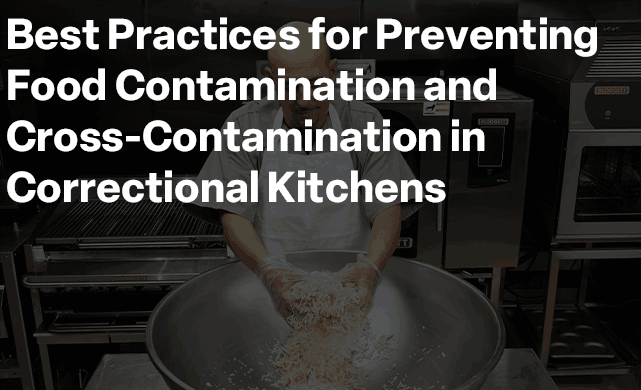Food contamination and cross-contamination can lead to foodborne illnesses, which can have severe consequences. Implementing effective practices to prevent contamination is essential in maintaining a safe and healthy food service environment. In this blog, we will explore the best practices for preventing food contamination and cross-contamination in correctional kitchens.
Training and Education: One of the fundamental steps in preventing food contamination is providing comprehensive training and education to kitchen staff. All personnel, including chefs, cooks, and food handlers, should receive proper training on food safety practices, personal hygiene, and the importance of preventing contamination. Regular refresher courses and certifications should be encouraged to ensure staff members stay up to date with the latest guidelines.
Personal Hygiene: Emphasizing good personal hygiene practices among staff is crucial. This includes proper handwashing techniques, the use of disposable gloves, and the use of hairnets or caps to prevent hair from falling into food. Staff should be trained to wash their hands thoroughly and frequently, especially before handling food, after using the restroom, touching their face, or handling raw ingredients.
Separation of Raw and Cooked Foods: To prevent cross-contamination, it is vital to separate raw and cooked foods at all stages of food preparation. This includes using separate cutting boards, utensils, and containers for raw and cooked items. Designating specific areas in the kitchen for raw and cooked food handling helps minimize the risk of cross-contamination.
Proper Food Storage: Correct storage practices play a significant role in preventing food contamination. All food items, including perishable and non-perishable goods, should be stored at appropriate temperatures. Raw meats should be stored separately from other food items to avoid potential bacterial transfer. Clear labeling and proper rotation of stock should be implemented to ensure that older products are used before newer ones.
Cleaning and Sanitization: Maintaining a clean and sanitized kitchen environment is crucial for preventing contamination. Regular cleaning schedules should be established, including the cleaning and sanitizing of utensils, cutting boards, surfaces, and equipment. All cleaning products should be food-safe and used according to manufacturer instructions. Regular pest control measures should also be implemented to prevent infestations.
Temperature Control: Temperature control is vital in preventing the growth of harmful bacteria. Correctional kitchens should implement strict temperature monitoring and control systems for both cooking and storage. Refrigerators and freezers should be maintained at appropriate temperatures, and regular checks should be conducted to ensure they are functioning correctly. Food should be cooked to the recommended internal temperatures to eliminate harmful bacteria.
Vendor and Ingredient Selection: Choosing reliable vendors and suppliers who prioritize food safety is crucial. Establish relationships with trusted suppliers who adhere to strict quality standards and food safety regulations. Ensure that all ingredients are fresh, properly labeled, and obtained from reputable sources.
Regular Inspections and Audits: Conducting regular inspections and audits of the correctional kitchen is essential to identify any potential food safety risks. Involve qualified food safety professionals or health inspectors to assess the kitchen's compliance with regulations and standards. These inspections can provide valuable feedback and help identify areas for improvement.
By implementing these best practices, correctional kitchens can significantly reduce the risk of food contamination and cross-contamination. Prioritizing staff training, personal hygiene, proper food storage, cleaning protocols, temperature control, and regular inspections will create a safer and healthier food service environment. By upholding these practices, correctional facilities can ensure the well-being of inmates and staff, maintaining food safety as a top priority.


















